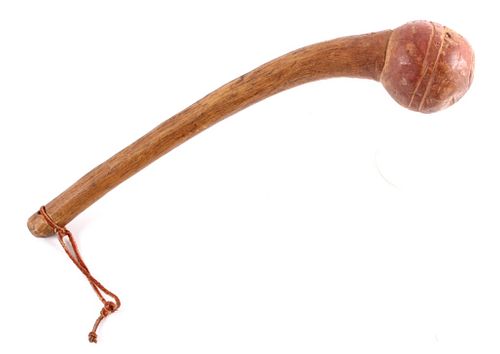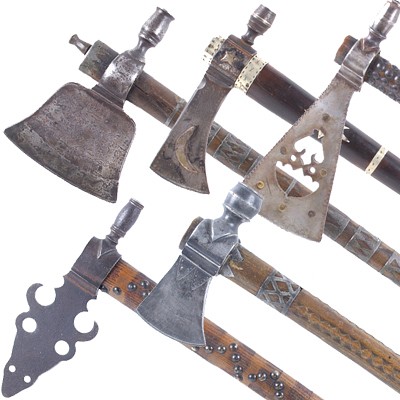Battle of Little Bighorn Sioux Ball Head War Club
Two ways to bid:
- Leave a max absentee bid and the platform will bid on your behalf up to your maximum bid during the live auction.
- Bid live during the auction and your bids will be submitted real-time to the auctioneer.
Bid Increments
| Price | Bid Increment |
|---|---|
| $0 | $5 |
| $50 | $10 |
| $100 | $25 |
| $500 | $50 |
| $1,000 | $100 |
| $2,000 | $250 |
| $5,000 | $500 |
| $10,000 | $1,000 |
| $25,000 | $2,500 |
| $100,000 | $5,000 |
About Auction
Oct 3, 2020
Fantastic historic American Indians Weapons, Tomahawks, War Clubs and Bead Work paired with 100's of Navajo Jewelry pieces and fine Luxury Jewelry make this a sale you won't want to miss! North American Auction Company tucker@naabid.com
- Lot Description
The lot offered for sale is possibly the most important and historic Battle of the Little Bighorn circa 1876 attributed War Club ever offered for public sale. This piece features a ball head carved wood war club showing excellent authentic Togia Lakota language carvings along the war club head. The war club has been examined and authenticated by renowned historian and Togia language expert, Wendell Grangaard of The Guns of History, Inc. The Togia language carvings are shown on the ball head as such: on the left side shows “Thunder Bear” and “Two Bulls”, on the top is marked “Cloud Medicine”, on the end is marked “Long Tree” and “Greasy Grass”, and along the bottom is marked, “His Road”, “Thunder Bear”, and “Iron Bear”. All of the names listed on the ball head are each Yanktonai Dakota Sioux Native American Indian Warriors. The Battle of the Little Bighorn is referred to by the Indian’s as the Battle of the Greasy Grass and commonly referred to by historians as Custer’s Last Stand. The historic story of Thunder Bear’s tremendous fight at the Battle of the Little Bighorn has been recorded by Edward Curtis in 1907 and can be found in Richard G. Hardoff’s book, “Indian Views of the Custer Fight: A Source Book” University of Oklahoma Press, Norman, 2005, Page 87 along with being documented by Edward Milligan in the book, “High Noon On The Greasy Grass: The Story of the Little Bighorn by Indians Who Were There” Bottineau Courant Print Bottineau, ND 1972 “Two Bull’s Story of the Custer Fight”. In 1930 Two Bulls, also signed on this war club in Togia and was known to have rushed into the battle with Thunder Bear, gave testimony to Welch, Mandan, N.D. November 19th, 1930…. “Then a white man came out of the trees, He was an officer. He had stripes on his sleeves, we ran at him. We clubbed him then. He died there…” Wendell Grangaard took testimony from a descendant of Two Bull, the Yanktonai Sioux who rode with Thunder Bear, near McLaughlin, South Dakota on the Standing Rock Reservation. They called the testimony of Two Bulls “When the Last of the Yanktonai want to the Battle of Little Bighorn”. The testimony given by Two Bull’s and told by his descendants follows the same line of events as the testimony by Thunder Bear to Edward S. Curtis in 1907 except showing more details. The story also included, “There was a soldier with stripes on his arms who mounted a sorrel horse and rode west. Thunder Bear come up beside the soldier to his left and Cotton Man on the right. Thunder Bear swung his war club at the soldier and almost knocked his head off. The soldier was carrying two revolvers – one in each hand as he fell, Thunder Bear grabbed one of the revolvers and Cotton Man grabbed the horse’s reins. There was a carbine in the scabbard on the horse, which Cotton Man took, as well as the horse. Where the other revolver went Thunder Bear (and Two Bulls) didn’t know.” This is the same telling of the story given by Two Bull’s to Welch, Mandan, N.D. in the above statement from November 19th, 1930 with more detail. “It was like fighting boys, the men were so tired and their rifles so poor”, said Two Bulls in the testimony he gave to Edward Milligan. It is believed that Thunder Bear’s testimony given to Curtis did not include the telling of the horrific death of this Officer due to his fear of reprisal from the whites. The soldier on the Sorrel Horse with the stripes on his arms was from Company C in George Armstrong Custer’s US 7th Cavalry, due to Custer’s orders to ride Sorrel’s. The soldier mentioned in this story could presumably have been Lt. Henry Moore Harrington who was given the command of Company C before the Battle of the Little Bighorn. Lt. Harrington’s body was never identified at the Battle site, even though his wife Grace Berard made several trips to the Battlefield to look for his body to no avail, conceivably due to the fact that he was so savagely killed by Thunder Bear and Two Bulls, as told in the above stories. The war club included in this lot is believed to be the exact club that would have been used in the story of the death of the Company C Officer that was killed by Thunder Bear, Cotton Man, and Two Bull’s during the battle. The War Club shows the proper patina and manufacture to be a correct period artifact along with the indisputable Togia Language Carvings that are present on the piece. The war club comes with the signed letter describing the piece’s history from Wendell Grangaard along with detailed illustrations showing the markings he has translated. Wendell Grangaard is the foremost knowledge on the Togia language along with the Battle of the Little Bighorn as he is the author of the book, “Documenting the Weapons Used at Little Bighorn” 2015. Wendell was also intricate in the authentication and examination of the historic George Armstrong Custer Captured Sharps Carbine from Chief Black Kettle that sold at auction for $127,000. Comes with documentation including a detailed description authenticating the piece signed by Wendell, along with illustrations showing the togia language carvings. The truly historic and important war club measures overall 18.5”L x 4”H with the head being 3.75” in diameter. Provenance: From a historic Eastern Montana American Indian Collection where the piece was found to be an authentic original, one of the finest collections of American Indian weaponry and antiquities in Montana.
- Shipping Info
-
North American Auction Company is proud to announce the opening of our new in-house, full-service shipping department. We have listened to you the customer and will now be handling all outgoing packages in our new shipping department. We are confident this new offering will allow for a smooth transition from auction block to your front step. We have partnered with preferred carriers to ensure a safe, efficient delivery that works best with your schedule. Please allow 14-21 days after complete invoice payment is made to package and ship your purchase. After you are notified of your winning bids from our company and your item invoice is paid in full our new shipping department will contact you. Make sure when signing up with our company that your preferred shipping information is up to date as this information will be used to estimate shipping cost. Once the items have been packaged our team will contact you for shipping payment. Shipping invoices and payment will be completely separately than the items invoice. Please notify the shipping department with any alternate request or instructions at mark@northamericanauctioncompany.com or 800-686-4216 ext. 3. For a shipping quote please contact the same information above. PLEASE NOTE a shipping quote price can fluctuate in price. Auction company is not responsible for actual shipping cost being higher than quoted shipping cost. Thank you for trusting North American Auction Co. with your bids and shipping. As our shipping department is brand new please understand that delays can be expected.
-
- Buyer's Premium



 EUR
EUR CAD
CAD AUD
AUD GBP
GBP MXN
MXN HKD
HKD CNY
CNY MYR
MYR SEK
SEK SGD
SGD CHF
CHF THB
THB
















